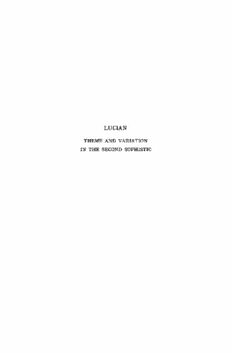Table Of ContentLUCIAN
THEME AND VARIATION
IN THE SECOND SOPHISTIC
MNEMOSYNE
BIBLIOTHECA CLASSICA BATAVA
COLLEGERUNT
W. DEN BOER • W. J. VERDENIUS • R. E. H. WESTENDORF BOERMA
BIBLIOTHECAE FASCICULOS EDENDOS CURAVIT
W. J. VERDENIUS, HOMERUSLAAN 53, ZEIST
SUPPLEMENTUM QUADRAGESIMUM PRIMUM
GRAHAM ANDERSON
LUCIAN
THEME AND VARIATION
IN THE SECOND SOPHISTIC
LUGDUNI BATAVORUM E. J. BRILL MCMLXXVI
LUCIAN
THEME AND VARIATION
IN THE SECOND SOPHISTIC
BY
GRAHAM ANDERSON
LUGDUNI BATAVORUM E. J. BRILL MCMLXXVI
ISBN 90 04 04735 2
Copyright 1976 by E. J. Brill, Leiden, The Netherlands
All rights reserved. No part of this book may be reprod11ced or
translated in any form, by print, photoprint, microfilm, microfirhe
or any other means witho11t written permiuon from the p11blisher
PRINTED IN THE NETHERLANDS
UXORI CARISSIMAE
CONTENTS
Preface. . . . IX
Abbreviations . XI
I. Theme and Variation: Lucian's Models and Methods . 1
II. Fantastic Description 23
III. Storytelling . . 41
IV. Characterisation 67
V. Rome. . . . . 85
VI. Drama I: Timon and the Miniatures 90
VII. Drama II: Four Characteristic Situations 103
VIII. Learning and Mock-Learning . . . . . rr3
IX. Arrangement of Themes I: Some Recurrent Patterns . 135
X. Arrangement of Themes II: Typical Problems . 150
XI. Conclusion . . . . . . . . . . . . . . . . 167
Appendix I: Cross-references and Lucian's Chronology 177
Appendix II: The Piscator Scheme: Some Tentative Origins. 182
Select Bibliography . . . . . . 187
Index of Passages of Lucian cited 193
Index of Proper Names. . 201
Index of Principal Motifs . 208
PREFACE
Lucian laughed at scholars who asked too many questions about
literature. He would have had grave doubts about the present work.
It began as a commentary on Lucian, and it now sets out to show
why Lucian is his own best commentator. He varies a small range
of material to an exhaustive degree, as few scholars in the past
century have failed to realise. But the implications of this store of
parallels have still to be fully explored: among ancient authors
Lucian offers us one of the most complete collections of internal
evidence, and this has yet to be applied systematically to a wide
range of scholarly questions. What kind of variation does he tend
to practise? Is he likely to borrow from a wide range of recondite
sources, when he could be varying one of his most familiar motifs
instead? And when he does borrow, how do the motifs already in his
repertoire affect his choice of new material? Does his variation-
technique stop at themes, or can he use the same facile methods
when arranging his work? And finally: is Lucian a hack or a virtuoso
-or both?
I have looked at a few simple procedures which Lucian uses in
order to make the most of his material, then traced them at work
in a number of different fields, from trips to the moon to learned
lectures on grammar; and I have applied them as evidence to a
number of familiar problems en route. Much of this work is neces-
sarily mere marginalia on the monumental explorations of Helm
and Bompaire. I have tried to begin where the latter left off, leaving
many of the intractable controversies almost untouched, in-
cluding Lucian's relationship with Menippus or the prosopography
of his victims. It is unlikely at this stage that internal evidence
will usher in any entirely new answers: but it can alter the balance
between two established viewpoints, or help to narrow the range
of really probable solutions. The important thing is that it should
be taken into account at all. It supports the view that Lucian is a
manipulator with fairly limited literary horizons: the aim of this
book is not to explain outside those horizons what can be explained
within them.
I have reserved two fields for more detailed treatment elsewhere.
To avoid any question of circularity I have not discussed any of
X PREFACE
the traditional dubia while attempting to build up a picture of
Lucian's methods and interests. Each of these works has its own
peculiar problems, and I intend to show elsewhere that de Saltatione,
Podagra and de Parasito reflect Lucian's response to various kinds
of recondite subject-matter. Nor have I dealt in detail with Lucian's
excursions into the novel and novella: I have discussedPhilopseudes,
Toxaris, Verae Historiae, the Onos, and de Dea Syria in a companion
volume under the title Studies in Lucian's Comic Fiction.
My debts are many: to Matthew Macleod and Ewen Bowie, who
examined this work as part of an Oxford D. Phil. thesis; to Bryan
Reardon and Christopher Robinson, for fruitful conversations on
Lucian; to my sometime colleagues John Richmond, Rae Astbury,
Ludwig Bieler and Michael Vickers, for unsparing help in fields
often far removed from my own; to Robin Nisbet, who first sug-
gested that I should work on Greek pseudos, and Roger Mynors,
who first harnessed me to Lucian; and most of all to Donald
Russell, who supervised my work as a µt(jot/\ot~wv and µt(joljie:u~~c:;,
and to my wife, who helped much and endured more.
Since the Renaissance Holland has found a special place for
Lucian. It is a pleasure to acknowledge the co-operation of E. J. Brill
in the publication of a difficult work at a difficult time; and the
generosity of the Jowett Trustees, whose subvention made publi-
cation possible.
University of Kent at Canterbury GRAHAM ANDERSON
September r975

